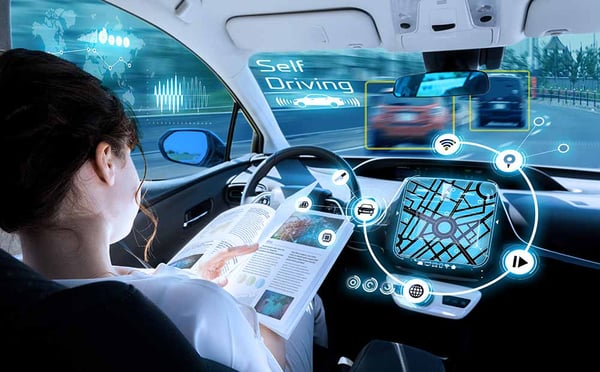
When Henry Ford started mass-producing the Model T in 1908, he sparked a revolution in the automotive industry. But no one would have thought it would come so far in such a short space of time. No one would have thought autonomous vehicle testing would even be a thing.
Yet here we are, just over a century after the Model T rolled off the production line and vehicle autonomy is now a reality. A new breed of cars will soon be rolling off the production line.
Understanding the Six Levels of Driving Automation
The Society of Automotive Engineers (SAE), recognizes six levels of vehicle automation which have also been adopted by the U.S. Department of Transportation. Understanding these is critical to answering our question of the day — “what is autonomous vehicle testing?”
So, what are the six autonomous vehicle levels?
Level 0: No Automation
Level 0 automation refers to cars that are 100% manually operated by the driver.
Level 1: Driver Assistance
Cars on this level only feature driver-assist functions such as speed monitoring and control.
Level 2: Partial Automation
These cars can steer themselves and control their speed. However, they still need human monitoring and the person monitoring can take control at any time.
Level 3: Conditional Automation
This is a step higher than level 2 as the vehicle can detect environmental conditions and respond accordingly. Human monitoring is still required.
Level 4: High Automation
Vehicles on this level can perform all driving tasks under specific conditions and use geofencing to keep cars from crashing.
Level 5: Full Automation
This is the highest level of vehicle automation where the vehicle can take care of all driving tasks and doesn’t require human input or monitoring.
How Do Autonomous Cars Work?
For cars to successfully drive autonomously, several components must work together seamlessly. A few essential ones include:
Several sensors
Lidar and radar
Actuators
Complex algorithms
Machine learning systems
Power processors and software
Batteries to power everything
Using sensors and geo-fencing, autonomous vehicles create and maintain maps of their surroundings for navigation. Cameras and ML systems detect traffic lights and other road signs as well as other vehicles and pedestrians. All the various inputs are then processed by onboard software which then plots the path the vehicle should take. The software then sends instructions to the vehicle’s actuators. These are responsible for driving functions such as acceleration, braking, and steering.
To ensure the vehicle follows traffic rules and successfully navigates through traffic and around obstacles, autonomous vehicles leverage a combination of:
Predictive modeling
Hard-coded rules
Obstacle avoidance algorithms
As you can see, there are so many moving pieces that go into ensuring that an autonomous vehicle functions properly. And that’s exactly why autonomous vehicle testing is a crucial part of successful vehicle autonomy.
What is Autonomous Vehicle Testing?
Technological advancements have led to the creation of advanced algorithms and robotics that are capable of taking over a driver's responsibilities. However, as much as technology has advanced over the years, it still isn’t infallible. And in the case of vehicles, it’s responsibility for the safety of the human occupants, other road users, and the environment.
This is why autonomous vehicle testing is a concern for consumers and regulatory authorities
So what exactly is autonomous vehicle testing?
Autonomous vehicle testing refers to the rigorous tests that are conducted on every part and component of a vehicle necessary to ensure it successfully functions autonomously. Besides mechanical functionality, other critical factors that are tested include:
Communication Tests
The success of vehicle autonomy is mainly dependent on communication. That’s why various tests are conducted to ensure there’s clear communication:
Between all components of the vehicle
Vehicle to vehicle (V2V) communication
With the infrastructure (V2I)
With other devices (V2D)
With other networks (V2N)
Virtual Simulation Tests
These are tests where the vehicle is tested in an environment that mimics everyday driving conditions and situations. This stage focuses on providing a safe environment to test if a vehicle performs as expected in the real world. This stage requires the use of a well-equipped autonomous vehicle testing facility certified to conduct autonomous vehicle testing.
Field Testing
This involves putting an autonomous vehicle in a real-world scenario (with safety measures in place of course). The test vehicle is then deployed and its performance monitored.
Battery Testing
Battery testing is a critical part of autonomous vehicles for many reasons. For one, the battery capacity of the vehicle determines the range of the vehicle. More importantly, however, the battery is a critical part of the electronic system in a vehicle. If the battery can’t last or is faulty, an autonomous vehicle can’t finish its mission. In extreme cases, a faulty battery can cause the vehicle to malfunction, thereby becoming a danger.
That’s why testing the depletion rate, dependability, and durability of batteries that power autonomous vehicles is important.
The Importance of Autonomous Vehicle Testing
While safety is the biggest reason for autonomous vehicle testing, there are other important reasons testing is essential. A few such include:
Innovate better solutions to current challenges.
Better predict how autonomous vehicles respond in different situations.
Gain consumer trust resulting in higher adoption rates.
Autonomous vehicle testing is essential to ensuring maximum safety and optimum performance of the vehicle. Its value can never be over-emphasized. Particularly at the fast pace the industry is moving, efficient testing is essential to ensuring brands produce products that exceed consumer and regulatory expectations.
Autonomous Vehicle Testing — Driving the Future to Perfection
Autonomous vehicle testing is key to taking the automotive industry to the next level. If you’re on a mission to help the automotive industry take the leap into the future, RCO Engineering is here to help you succeed. We offer several services designed to help players in the automotive industry fast-track their progress.
So, if you’re ready to take the automotive industry into its glorious future, work with us. We’re here to give you the support you need.

Comments